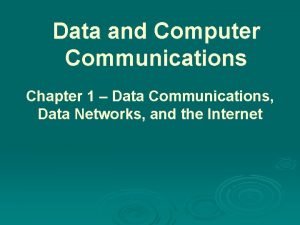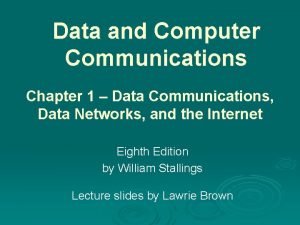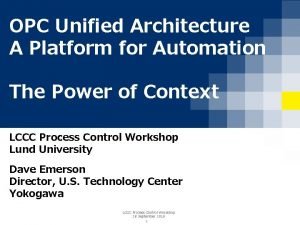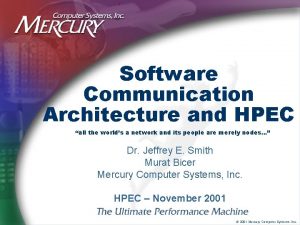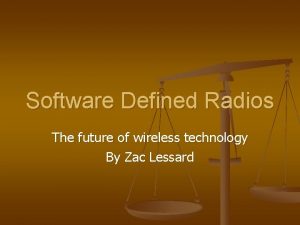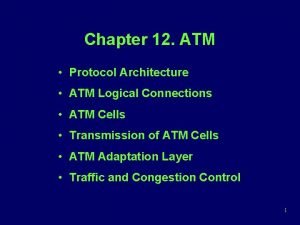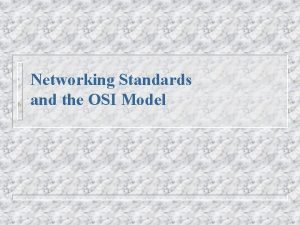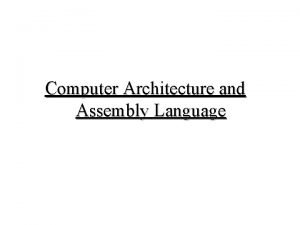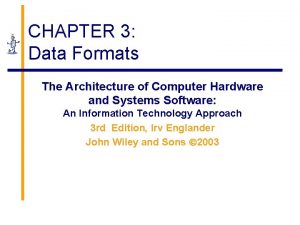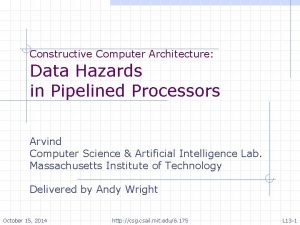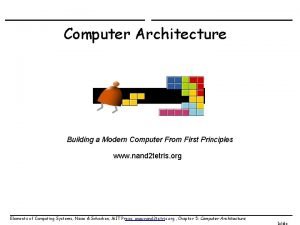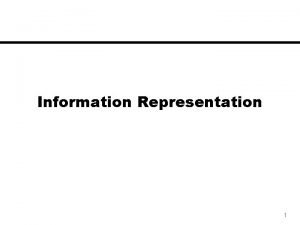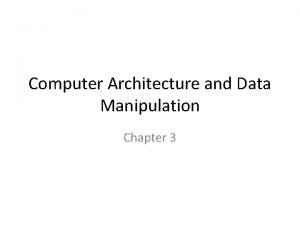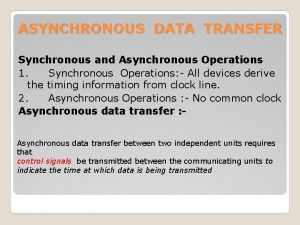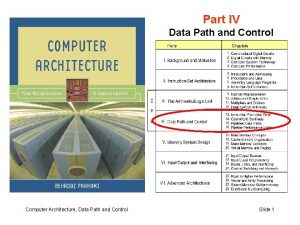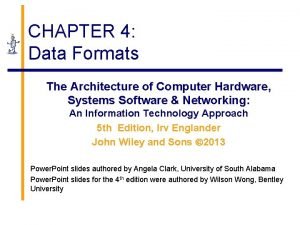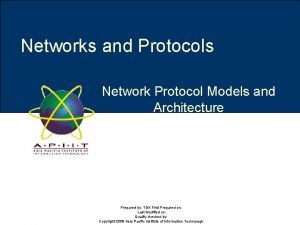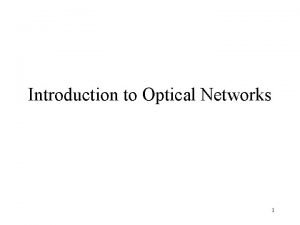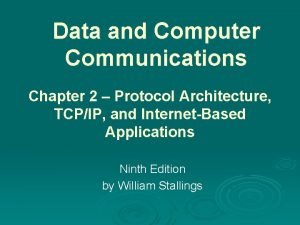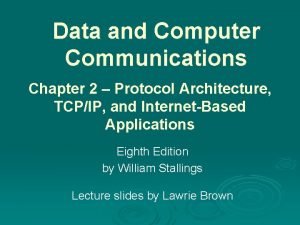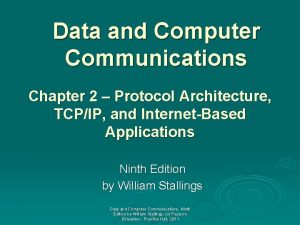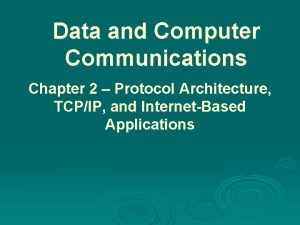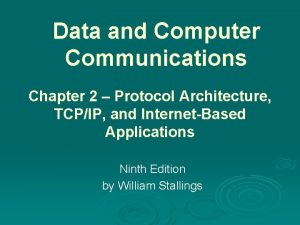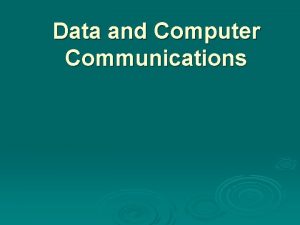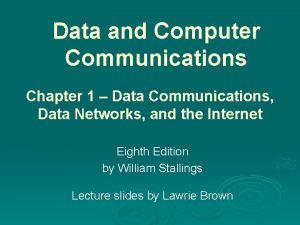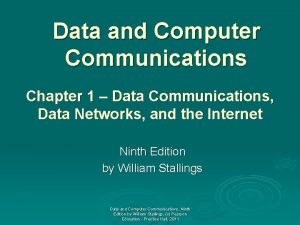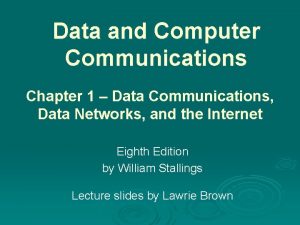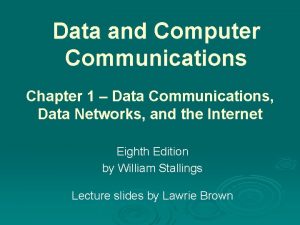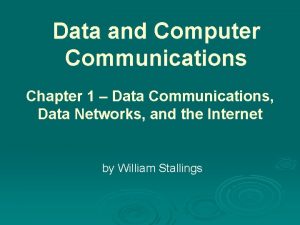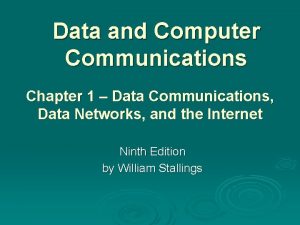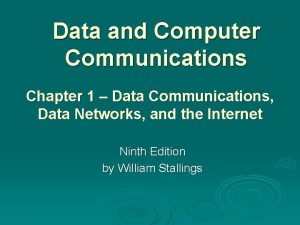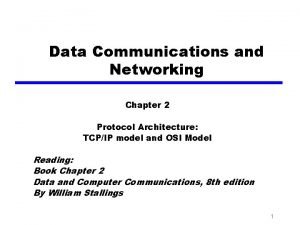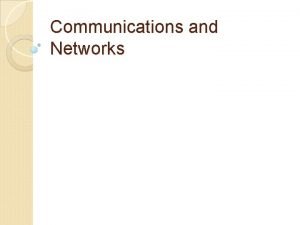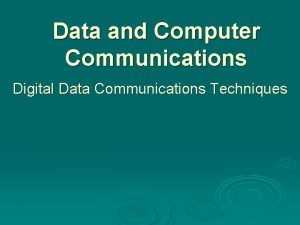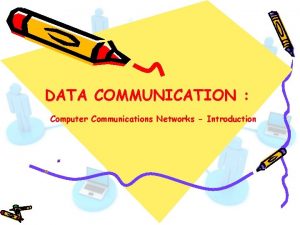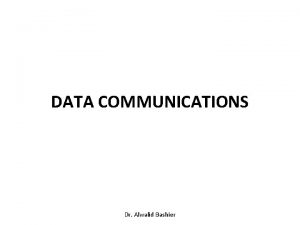Data and Computer Communications Chapter 2 Protocol Architecture


































- Slides: 34

Data and Computer Communications Chapter 2 – Protocol Architecture, TCP/IP, and Internet-Based Applications Eighth Edition by William Stallings Lecture slides by Lawrie Brown

Protocol Architecture, TCP/IP, and Internet-Based Applications Ø To destroy communication completely, there must be no rules in common between transmitter and receiver—neither of alphabet nor of syntax —On Human Communication, Colin Cherry

Need For Protocol Architecture Ø data exchange can involve complex procedures, cf. file transfer example Ø better if task broken into subtasks Ø implemented separately in layers in stack l l each layer provides functions needed to perform comms for layers above using functions provided by layers below Ø peer layers communicate with a protocol

Key Elements of a Protocol Ø syntax - data format Ø semantics - control info & error handling Ø timing - speed matching & sequencing

TCP/IP Protocol Architecture Ø developed by US Defense Advanced Research Project Agency (DARPA) Ø for ARPANET packet switched network Ø used by the global Internet Ø protocol suite comprises a large collection of standardized protocols

Simplified Network Architecture

TCP/IP Layers Ø no official model but a working one l l l Application layer Host-to-host, or transport layer Internet layer Network access layer Physical layer

Physical Layer Ø concerned with physical interface between computer and network Ø concerned with issues like: l l characteristics of transmission medium signal levels data rates other related matters

Network Access Layer Ø exchange of data between an end system and attached network Ø concerned with issues like : l l l destination address provision invoking specific services like priority access to & routing data across a network link between two attached systems Ø allows layers above to ignore link specifics

Internet Layer (IP) Ø routing functions across multiple networks Ø for systems attached to different networks Ø using IP protocol Ø implemented in end systems and routers Ø routers connect two networks and relays data between them

Transport Layer (TCP) Ø common layer shared by all applications Ø provides reliable delivery of data Ø in same order as sent Ø commonly uses TCP

Application Layer Ø provide support for user applications Ø need a separate module for each type of application

Operation of TCP and IP

Addressing Requirements Ø two levels of addressing required Ø each host on a subnet needs a unique global network address l its IP address Ø each application on a (multi-tasking) host needs a unique address within the host l known as a port

Operation of TCP/IP

Transmission Control Protocol (TCP) usual transport layer is (TCP) Ø provides a reliable connection for transfer of data between applications Ø a TCP segment is the basic protocol unit Ø TCP tracks segments between entities for duration of each connection Ø

TCP Header

User Datagram Protocol (UDP) Ø an alternative to TCP Ø no guaranteed delivery Ø no preservation of sequence Ø no protection against duplication Ø minimum overhead Ø adds port addressing to IP

UDP Header

IP Header

IPv 6 Header

TCP/IP Applications Ø have a number of standard TCP/IP applications such as l l l Simple Mail Transfer Protocol (SMTP) File Transfer Protocol (FTP) Telnet

Some TCP/IP Protocols

OSI Ø Open Systems Interconnection Ø developed by the International Organization for Standardization (ISO) Ø has seven layers Ø is a theoretical system delivered too late! Ø TCP/IP is the de facto standard

OSI Layers

OSI v TCP/IP

Standardized Protocol Architectures

Layer Specific Standards

Service Primitives and Parameters Ø define services between adjacent layers using: Ø primitives to specify function performed Ø parameters to pass data and control info

Primitive Types REQUEST A primitive issued by a service user to invoke some service and to pass the parameters needed to specify fully the requested service INDICATION A primitive issued by a service provider either to: indicate that a procedure has been invoked by the peer service user on the connection and to provide the associated parameters, or notify the service user of a provider-initiated action RESPONSE A primitive issued by a service user to acknowledge or complete some procedure previously invoked by an indication to that user CONFIRM A primitive issued by a service provider to acknowledge or complete some procedure previously invoked by a request by the service user

Traditional vs Multimedia Applications Ø traditionally Internet dominated by info retrieval applications l l typically using text and image transfer eg. email, file transfer, web Ø see increasing growth in multimedia applications l l involving massive amounts of data such as streaming audio and video

Elastic and Inelastic Traffic Ø elastic traffic l l l can adjust to delay & throughput changes over a wide range eg. traditional “data” style TCP/IP traffic some applications more sensitive though Ø inelastic traffic l l l does not adapt to such changes eg. “real-time” voice & video traffic need minimum requirements on net arch

Multimedia Technologies

Summary Ø introduced need for protocol architecture Ø TCP/IP protocol architecture Ø OSI Model & protocol architecture standardization Ø traditional vs multimedia application needs
 Data and computer communications 10th edition
Data and computer communications 10th edition Data and computer communication
Data and computer communication Data and computer communications
Data and computer communications William stallings data and computer communications
William stallings data and computer communications Computer architecture vs computer organization
Computer architecture vs computer organization 3 bus architecture
3 bus architecture Basic computer design
Basic computer design Open platform communications unified architecture
Open platform communications unified architecture Software communication architecture
Software communication architecture Software communications architecture
Software communications architecture Cisco unified communications architecture
Cisco unified communications architecture Atm cont
Atm cont Telecommunication meaning
Telecommunication meaning Business data communications and networking
Business data communications and networking Business data communications and networking
Business data communications and networking Introduction to data communications and networking
Introduction to data communications and networking Business data communications and networking
Business data communications and networking Osi a model for computer communications standards
Osi a model for computer communications standards Data representation in computer architecture
Data representation in computer architecture Data formats in computer architecture
Data formats in computer architecture Data hazards in computer architecture
Data hazards in computer architecture Program counter nand2tetris
Program counter nand2tetris Data representation in computer organization
Data representation in computer organization Data manipulation in computer architecture
Data manipulation in computer architecture Asynchronous data transfer
Asynchronous data transfer Data path in computer architecture
Data path in computer architecture Data formats in computer architecture
Data formats in computer architecture Chapter 4 communications and documentation
Chapter 4 communications and documentation Chapter 3 network protocols and communications
Chapter 3 network protocols and communications Security architecture for the internet protocol
Security architecture for the internet protocol Network protocol architecture
Network protocol architecture In a telecommunications network architecture, a protocol is
In a telecommunications network architecture, a protocol is Protocol architecture
Protocol architecture Network protocol architecture
Network protocol architecture Dect protocol architecture
Dect protocol architecture

